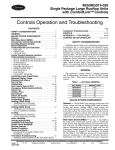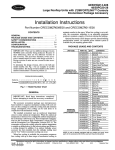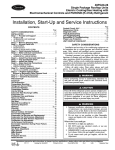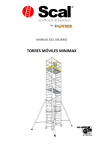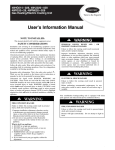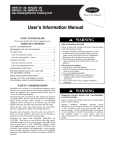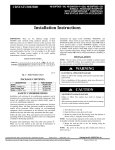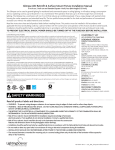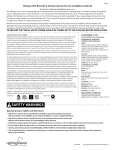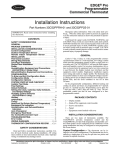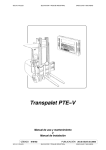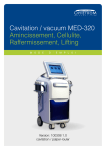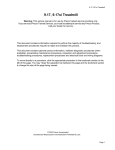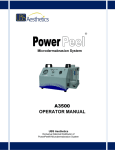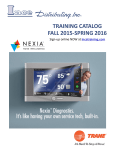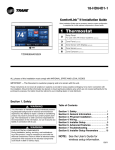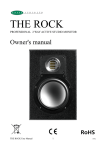Download Carrier CRSMKDET001C00 User's Manual
Transcript
48/50HG014-028 Single-Package Rooftop Units Accessory Return and Supply Smoke Detectors Installation Instructions Part No. CRSMKDET001C00 and CRSMKSUP001A00 CONTENTS GENERAL . . . . . . . . . . . . . . . . . . . . . . . . . . . . . . . . . . . . . . . . 1 SAFETY CONSIDERATIONS . . . . . . . . . . . . . . . . . . . . . . 1 INSTALLATION . . . . . . . . . . . . . . . . . . . . . . . . . . . . . . . . . 2-5 Check Package Contents. . . . . . . . . . . . . . . . . . . . . . . . . 2 Return Air Smoke Detector Installation. . . . . . . . . . . 2 Supply Air Smoke Detector Installation . . . . . . . . . . 5 Configuring the ComfortLink™ Controller. . . . . . . . 5 OPERATION . . . . . . . . . . . . . . . . . . . . . . . . . . . . . . . . . . . . .5,6 MAINTENANCE . . . . . . . . . . . . . . . . . . . . . . . . . . . . . . . . . . 7 Cleaning Procedure . . . . . . . . . . . . . . . . . . . . . . . . . . . . . . 7 Filter Replacement . . . . . . . . . . . . . . . . . . . . . . . . . . . . . . . 7 Board Replacement . . . . . . . . . . . . . . . . . . . . . . . . . . . . . . 7 TROUBLESHOOTING. . . . . . . . . . . . . . . . . . . . . . . . . . . .7,8 Smoke Entry Tests . . . . . . . . . . . . . . . . . . . . . . . . . . . . . . . 7 • AIRFLOW TEST • SMOKE RESPONSE TEST Standby, Alarm and Sensitivity Tests. . . . . . . . . . . . . 8 • STANDBY AND TROUBLE TEST • ALARM TESTS • SENSITIVITY TEST GENERAL An HVAC (heating, ventilation and air-conditioning) system supplies conditioned air to virtually every area of a building. Smoke introduced into this air duct system will be distributed throughout the entire building. Smoke detectors designed for use inside the unit are used to sense the presence of smoke passing through the unit. The smoke detector utilizes photoelectric technology for the detection of smoke. This detection method, when combined with an efficient ducting design, samples air passing through the unit. If sufficient smoke is sensed, an alarm signal is initiated and the ComfortLink controls will shut down the unit. With the unit shut down, the unit will not blow toxic smoke and fire gases throughout the areas served by the duct system. The return air smoke detector is part number CRSMKDET001C00. The supply air smoke detector is part number CRSMKSUP001A00. SAFETY CONSIDERATIONS Follow all safety codes. Wear safety glasses and work gloves. Use care when handling and installing the accessory. Before performing service or maintenance operations on unit, turn off main power switch to unit. Electrical shock could cause personal injury. The National Fire Protection Association has established that DUCT DETECTORS MUST NOT BE USED AS A SUBSTITUTE FOR OPEN AREA DETECTOR PROTECTION as a means of providing life safety. Nor are they a substitute for early warning in a building’s regular fire detection system. Carrier supports this position and strongly recommends that the user read NFPA Standards 90A, 72, and 101. This smoke detector is listed per UL 268A. This device will not operate without electrical power. Fire situations may cause an interruption of power. The system safeguards should be discussed with your local fire protection specialist. This device will not sense smoke unless the ventilation system is operating and the cover is installed. For this detector to function properly, it MUST be installed according to the instructions in this manual. Furthermore, the detector MUST be operated within ALL electrical and environmental specifications listed in this manual. Failure to comply with these requirements may prevent the detector from activating when smoke is present in the air duct. Installation and servicing of air-conditioning equipment can be hazardous due to system pressure and electrical components. Only trained and qualified service personnel should install, repair, or service air-conditioning equipment. Untrained personnel can perform the basic maintenance functions of cleaning coils and filters and replacing filters. All other operations should be performed by trained service personnel. When working on air-conditioning equipment, observe precautions in the literature, tags and labels attached to the unit, and other safety precautions that may apply. Manufacturer reserves the right to discontinue, or change at any time, specifications or designs without notice and without incurring obligations. PC 111 Catalog No. 534-80096 Printed in U.S.A. Form 48/50HG-19SI Pg 1 2-02 Replaces: 48/50HG-17SI Book 1 1 4 4 Tab 1a 1b 6a 6b INSTALLATION NOTE: For horizontal applications it is easiest to install the smoke detector prior to making duct connections. 1. Open the hinged electrical/compressor access door and secure. 2. Find the 2 plugs located above compressor B1, remove and discard. Cut holes in the insulation located behind the partition. 3. Remove cover from smoke detector. The screws will remain captured in the cover. 4. Place foam gaskets over each sampling tube on smoke detector. (See Fig. 1.) 5. Remove one knockout from top of smoke detector. 6. Insert stripped ends of wire harness through knockout and wire to smoke detector as shown in Fig. 3. 7. Provide strain relief for wires by attaching wire tie to ground screw located next to the knockout in the smoke detector. Tighten the wire tie. 8. Slide smoke detector into holes in partition with the terminal block to the right. Do not secure at this time. 9. Slide sampling tube into left-hand hole of smoke detector. It might be necessary to tilt the smoke detector upwards in order properly align the sampling tube. 10. Remove the unit side panel at the return end of the unit. Save screws for use later. 11. Mount the sampling tube support bracket to the cross member with two 1/4AB-14 5/8-in. screws as shown in Fig. 4. Insert large snap bushing into hole in bracket. 12. Slide sampling tube into bracket, making sure that the sampling holes point down. Pull the sampling tube so that it is flush with the smoke detector. 13. Return to Electrical/Compressor section and secure sampling tube to smoke detector with two no. 6 self-tapping screws. 14. Attach smoke detector to partition using two, 8-18 3/4-in. pan head screws. When installing the smoke detector in the unit, follow all local codes. Damage to unit may result. Check Package Contents — Remove accessory packaging and inspect shipment for damage. If any damage is found, file a claim with the shipping agent immediately. If any item is missing or any part does not assemble properly, notify your Carrier distributor. Tables 1A and B list the accessory package contents. Figure 1 shows the smoke detector. Table 1A — Accessory Package Contents — Return Air Smoke Detector (CRSMKDET001C00) ITEM Smoke Detector with Cover Sampling Tube (long) Sampling Tube Filters Test Magnet Foam Gaskets Screw, no. 6 Self Tapping Tube End Plug (large) Sampling Tube Support Bracket Screw, 8-18 3/4-in. Pan Head Screw, 1/4AB-14 5/8-in. Small Snap Bushing Large Snap Bushing Harness Assembly (4-Wires, short) Wire Tie, Screw Mounted QUANTITY 1 1 2 1 2 2 1 1 2 2 1 1 1 1 Table 1B — Accessory Package Contents — Supply Air Smoke Detector (CRSMKSUP001A00) ITEM Smoke Detector with Cover Sampling Tube (short) Sampling Tube Filters Test Magnet Foam Gaskets Tube End Plug (small) Screw, 8-18 3/4-in. Pan Head Small Snap Bushing Harness Assembly (4-Wires, long) Wire Tie, Screw Mounted Wire Tie Screw, no. 8 Self Tapping Screw, no. 10 QUANTITY 1 1 2 1 2 1 2 1 1 5 1 1 2 Do not overtighten the screws. Damage to smoke detector may result. 15. Return to side panel and insert tube end plug into sampling tube. 16. Replace the unit side panel. 17. Return to Electrical/Compressor section and insert sampling tube filters into both sampling tube holders. (See Fig. 1.) 18. Install the snap bushing in the center knockout underneath the control terminal strips located in the bottom right-hand corner of the control box. 19. Feed wires through snap bushing and connect to appropriate terminals as shown in Fig. 3. 20. Restore power to the unit. 21. Configure ComfortLink™ controller as specified in Configuring the ComfortLink Controller on page 5. 22. Perform Standby, Alarm, and Sensitivity Tests on page 7. At a minimum, the Magnet test should be performed to verify smoke detector wiring. 23. Replace smoke detector cover. 24. Check for alarms. Correct any problems. Return Air Smoke Detector Installation — The return air smoke detector is to be installed in the predrilled holes located above compressor B1 in the electrical/ compressor section (Fig. 2). Prior to installation of this accessory, make sure all power is disconnected to the unit and locked out. Failure to disconnect power supply prior to servicing may result in serious injury. 2 FOAM GASKETS CONDUIT HOLES SAMPLING TUBE FILTERS PLASTIC SAMPLING TUBE DETECTOR HOUSING TERMINAL STRIP POWER BOARD PLASTIC SAMPLING TUBE SELF-TAPPING SCREW COVER MOUNTING SCREWS DETECTOR BOARD DETECTOR COVER Fig. 1 — Smoke Detector SMOKE DETECTOR Fig. 2 — Return Air Smoke Detector Location 3 Fig. 3 — Return Air Smoke Detector Wiring SAMPLING TUBE SUPPORT BRACKET Fig. 4 — Sampling Tube Support Bracket 4 Supply Air Smoke Detector Installation — The supply air smoke detector is to be installed in the predrilled holes located on the front of the first indoor blower (Fig. 5). 20. 21. 22. 23. Prior to installation of this accessory, make sure all power is disconnected to the unit and locked out. Failure to disconnect power supply prior to servicing may result in serious injury. 24. 25. 1. Open the indoor fan access door and secure. 2. Open the hinged electrical/compressor access door and secure. 3. Disconnect wires located on the left-hand side of the fan deck. On 48HG units, the indoor fan plug and the limit switch quick connects must be disconnected. On 50HG units, only the indoor fan plug must be disconnected. 4. Find the 2 plugs located in the blower side plate. Remove the plugs and discard. It will be necessary to remove some of the tape holding the plugs in place. 5. Remove cover from smoke detector. The screws will remain captured in the cover. 6. Place foam gaskets over each sampling tube on smoke detector. See Fig. 1. 7. Remove one knockout from top of smoke detector. 8. Insert stripped ends of wire harness through knockout and wire to smoke detector as shown in Fig. 6. 9. Provide strain relief for wires by attaching wire tie to ground screw located next to the knockout in the smoke detector. Tighten wire tie. 10. Secure sampling tube in inlet closest to the smoke detector electronics using the no. 8 self-tapping screw provided. See Fig. 1 for an example on how to connect a sampling tube. Be sure to connect the sampling tube to the middle hole. Insert plug into the end of the sampling tube. 11. Slide smoke detector into holes in partition with the terminal block at the top and secure using two, 8-18 3/4-in. pan head screws. 26. 27. 28. 29. top of the filter section, down the outside of the control box and through the snap bushing. See Fig. 5 and 6. Connect wires to terminal strips as shown in Fig. 5 and 6. Restore power to the unit. Configure ComfortLink™ controller as specified in Configuring the ComfortLink Controller below. Perform Standby, Alarm, and Sensitivity Tests on page 7. At a minimum, the Magnet test should be performed to verify smoke detector wiring. Turn off power to the unit. Replace smoke detector cover. Do not overtighten screws. Reconnect the indoor fan plug and the limit switch wires if applicable. Close the indoor fan section door. Restore power to the unit and check for alarms. Correct any problems encountered. Close Electrical/Compressor section door. Configuring the ComfortLink Controller — Configuration settings for the ComfortLink controller are changed by using the Scrolling Marquee Display. A password may be required to edit the configurations, depending on the previous settings configured in the unit. Default password is “1111”. Use the arrow keys to scroll the red LED on the display to the “Configuration” position and press ENTER . Scroll through the menu until UNIT is found and press ENTER . After reaching the UNIT sub-menu, scroll to FS.SW (Fire Shutdown Input) and press ENTER twice, change the value to 1 (Normal Open) with the arrow keys, press ENTER again. Press ESCAPE three times to return to the top level of the menu. Additional information about changing configurations can be found in the Control and Troubleshooting Guide for 48/50HG units. OPERATION The smoke detector must be tested and maintained regularly following NFPA 72 requirements. The smoke detector should be cleaned at least once a year. Damage to equipment may result. Do not overtighten screws. Damage to smoke detector may result. The smoke detector accessories contain a photoelectric detector approved for an extended air speed range of 100 to 4000 feet per minute (0.5 to 20.3 m/s) and an operational temperature range of 32 to 131 F (0° to 55 C). Do not operate the smoke detector out of these ranges. The smoke detector operates on 24 VAC, 120 VAC, or 240 VAC. The thermostat power terminals on the unit are used to power the smoke detector. Alarm and supervisory relay contacts are available for control panel interface (alarm initiation), HVAC control, and other auxiliary functions. Auxiliary relays are also provided for fan shut down or signaling of up to 9 other detectors in the loop for multiple fan shut down. The smoke detector is not designed for 2-wire applications. The smoke detector can be reset by a momentary power interruption, by the reset button on the front cover, by the control panel, or by the remote reset accessory. The smoke detector incorporates a cover tamper feature that provides a trouble signal after 20 minutes if the cover is removed or improperly installed. Proper installation of the cover removes the trouble condition. 12. Insert sampling tube filters into both sampling tube holders. See Fig. 1. 13. Remove and save the two screws securing the indoor fan sled to the unit. 14. Slide the indoor fan sled out until the back side of the first blower is accessible. 15. Attach wire harness to fan side plate using the 4 screw wire ties and no. 10 screws provided. See Fig. 5 for clarification. 16. Slide in the indoor fan deck and secure using screws saved from Step 13. 17. Attach wire harness to top of Circuit C filter drier (and point B if two circuits) in Fig. 5, using wire tie provided. Make sure that the wire harness is tight. 18. In the Electrical/Compressor section, install snap bushing in the center knockout underneath the terminal strips located in the bottom right-hand corner of the control box. 19. Route wires from the filter drier to the control box. Wires should follow existing wires through grommet located on 5 USE #10 SCREWS PROVIDED TO ATTACH WIRE TIES ROUTE WIRES AS SHOWN SUPPLY SMOKE DETECTOR SUPPLY FAN, VIEW FROM INSIDE UNIT Fig. 5 — Supply Smoke Detector Location and Wire Routing Fig. 6 — Supply Smoke Detector Wiring 6 MAINTENANCE 5. Secure board with the two mounting screws. 6. Re-connect wiring to terminal block. Cleaning Procedure — Notify the proper authorities that the smoke detector system is undergoing maintenance, and that the system will temporarily be out of service. Disable the zone or system undergoing maintenance to prevent unwanted alarms and possible dispatch of the fire department. AIR FILTERS 1. Turn off power to the system. 2. Remove and inspect sampling tube filters. 3. If filters are heavily coated with dirt, replace them with new filters. If they are not heavily coated, use a vacuum cleaner or compressed air nozzle to remove dust, then reinstall the filters. PHOTO DETECTOR BOARD 1. Remove the screen by gently grasping on each side and pulling straight off. 2. Lift the photo chamber in the same fashion. Vacuum the screen and cover. Use clean, compressed air to loosen and blow out any remaining debris. 3. Vacuum photo chamber, then use clean compressed air to blow area clean. 4. Replace the chamber by pressing it onto the base. Press the screen into place. It should fit tightly on the chamber. TROUBLESHOOTING Test and maintain unit smoke detectors as recommended in NFPA 72. Before conducting these tests, notify the proper authorities that the smoke detection system will be temporarily out of service. Disable the system under test to prevent unwanted alarms. Smoke Entry Tests AIRFLOW TEST — The smoke detector is designed to operate over an extended air speed range of 100 to 4000 fpm. To verify sufficient sampling of unit air, turn on the 48/50HG unit indoor fan using the Service Test function (see Controls and Troubleshooting Guide for details on Service Test) and use a manometer to measure the differential pressure between the two sampling tubes. The differential pressure should measure at least 0.0015 in. wg and no more than 1.2 in. wg. Because most commercially available manometers cannot accurately measure very low pressure differentials, applications with less than 500 fpm of unit air speed may require the use of a currentsourcing pressure transmitter or the use of aerosol smoke (see Smoke Response Test below). SMOKE RESPONSE TEST — Drill a 1/4-in. hole 3-ft upstream from the unit smoke detector. Use the Service Test function (see Controls and Troubleshooting Guide for details on Service Test) to turn on the 48/50HG unit indoor fan. Measure the air velocity with an anemometer. Air speed must be at least 100 fpm. If the air speed is greater than 500 fpm, use a conventional manometer to measure differential pressure between the sampling tubes. Spray aerosol smoke into the unit through the 1/4-in. hole for 5 seconds. Wait two minutes for the unit smoke detector to alarm. If the unit smoke detector alarms, then air is flowing through the detector. Remove the unit smoke detector cover and blow out the residual aerosol smoke from the chamber and reset the unit smoke detector. Use duct tape to seal the aerosol smoke entry hole. To determine if smoke is capable of entering the sensing chamber, visually identify any obstructions. Plug the exhaust and inlet tube holes to prevent unit air from carrying smoke away from the detector head, then blow smoke directly at the head to cause an alarm. Filter Replacement — The filters do not substantially affect smoke detector performance even when up to 90% of the filter is clogged. Quarterly visual inspection usually suffices to determine whether the filters should be replaced. Only a high percentage of contamination affects performance. If further testing is required, compare differential pressure readings with and without the filters installed. If the difference exceeds 10%, then replace the filters. The pressure differential should never fall below 0.0015 in. wg. Board Replacement SMOKE DETECTOR BOARD REPLACEMENT 1. Remove the two detector board mounting screws. 2. Pull gently on the board to remove it. 3. To replace the board, align the board mounting features, holes, and the interconnect terminals. Push the board into place. 4. Secure board with the two mounting screws. POWER BOARD REPLACEMENT 1. Disconnect wiring from the terminal block. 2. Remove the two power board mounting screws. 3. Pull gently on the board to remove it. 4. To replace the board, align the board mounting features, holes, and the interconnect terminals. Push the board into place. Remove the plugs after this test, or the smoke detector will not function properly and damage may result. 7 Standby, Alarm and Sensitivity Tests — The cover of the smoke detector must be removed to perform these tests. STANDBY AND TROUBLE TEST Standby — Look for presence of flashing green LED. The LED should flash approximately every 10 seconds. Trouble — If the detector LED does not flash, then the detector lacks power (check TB4), the detector board is missing (replace), the cover has been missing or not secured properly for more than 20 minutes (secure cover properly), or the unit is defective (return for repair). Test — The trouble condition can be caused intentionally to verify correct operation of the system. Remove the detector board to cause an alarm. Cover Tamper — If the cover is removed or not properly secured for a period longer than 20 minutes, a trouble signal is generated to indicate the cover is missing. ALARM TESTS Magnet Test 1. Place the painted surface of the magnet onto the TEST locator on the bottom of the housing. 2. The red alarm LED on the detector should switch on. Verify system control panel alarm status and control panel execution of all intended auxiliary functions (i.e., fan shutdown, damper control, etc.). 3. The detector must be reset by the front cover reset button. SENSITIVITY TEST — After verification of alarm capability, use a field-supplied voltmeter to check detector sensitivity. The housing cover must be removed to perform this test. If readings indicate that the detector head is outside of the acceptable range that is printed on the label of the detector, the detector chamber requires cleaning. Copyright 2002 Carrier Corporation Manufacturer reserves the right to discontinue, or change at any time, specifications or designs without notice and without incurring obligations. PC 111 Catalog No. 534-80096 Printed in U.S.A. Form 48/50HG-19SI Pg 8 2-02 Replaces: 48/50HG-17SI Book 1 1 4 4 Tab 1a 1b 6a 6b









